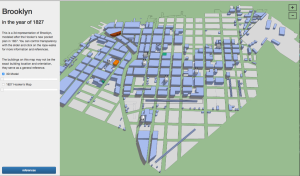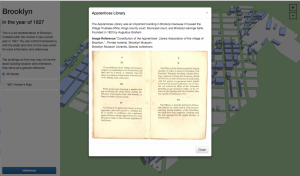To edit code, use visual studio 2010 or newer. Original images are available inside an Adobe PS psd file.
This tool lets you overlay maps of Brooklyn, and vary the transparency.
GitHub repo for the project!
Download Project Executable! (Windows)
Sources:
Lionel Pincus and Princess Firyal Map Division, The New York Public Library. (1878). Colton’s New York City : Brooklyn, Jersey City, Hoboken, etc. Retrieved from http://digitalcollections.nypl.org/items/75058670-f3a2-0130-4cc1-58d385a7b928
Lionel Pincus and Princess Firyal Map Division, The New York Public Library. (19–?). Map showing proposed extension of Flatbush Avenue to Brooklyn Bridge. Retrieved from http://digitalcollections.nypl.org/items/340c4540-d350-012f-2c90-58d385a7b928
Lionel Pincus and Princess Firyal Map Division, The New York Public Library. (1919). Brooklyn – Liberty Loan Committee – division of districts. Retrieved from http://digitalcollections.nypl.org/items/20d2f230-d2ac-012f-3549-58d385a7bbd0
Lionel Pincus and Princess Firyal Map Division, The New York Public Library. (1906). Brooklyn and vicinity. Retrieved from http://digitalcollections.nypl.org/items/9defba10-d299-012f-0a03-58d385a7bbd0
Lionel Pincus and Princess Firyal Map Division, The New York Public Library. (1907). Map of the Borough of Brooklyn, City oh New York. Showing street pavements other than cobble stone on January first, 1907. Retrieved from http://digitalcollections.nypl.org/items/ad8f6ba0-d296-012f-6380-58d385a7bbd0
Lionel Pincus and Princess Firyal Map Division, The New York Public Library. Brooklyn land use policy Retrieved from http://digitalcollections.nypl.org/items/c42cb93f-8db8-ca65-e040-e00a18064e5c
Lionel Pincus and Princess Firyal Map Division, The New York Public Library. (1898). Guide map of Brooklyn, Kings County, N.Y. ….for Brooklyn daily eagle almanac. Retrieved from http://digitalcollections.nypl.org/items/c6d9ae6e-07ab-24cf-e040-e00a18060887
Lionel Pincus and Princess Firyal Map Division, The New York Public Library. (1776-10-19). A plan of New York Island, with part of Long Island, Staten Island & east New Jersey : with a particular description of the engagement on the woody heights of Long Island, between Flatbush and Brooklyn, on the 27th of August 1776 between His Majesty’s forces commanded by General Howe and the Americans under Major General Putnam, shewing also the landing of the British Army on New-York Island, and the taking of the city of New-York &c. on the 15th of September following, with the subsequent disposition of both the armies Retrieved from http://digitalcollections.nypl.org/items/510d47da-ee3b-a3d9-e040-e00a18064a99
Lionel Pincus and Princess Firyal Map Division, The New York Public Library. (1767). Plan of the town of Brooklyn and part of Long Island. Retrieved from http://digitalcollections.nypl.org/items/871fda48-ba46-c1d9-e040-e00a18064c0a





